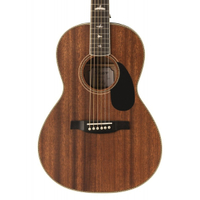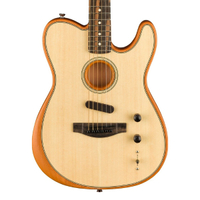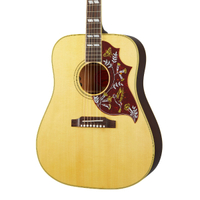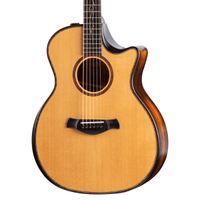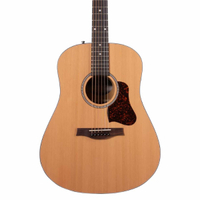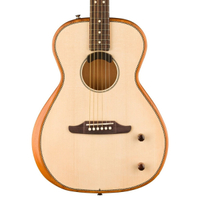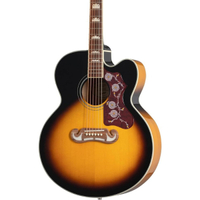Best acoustic guitars 2025: Super steel string acoustics for all players and budgets
Our pick of the very best flat tops from Taylor, Martin, Gibson, Fender and loads more
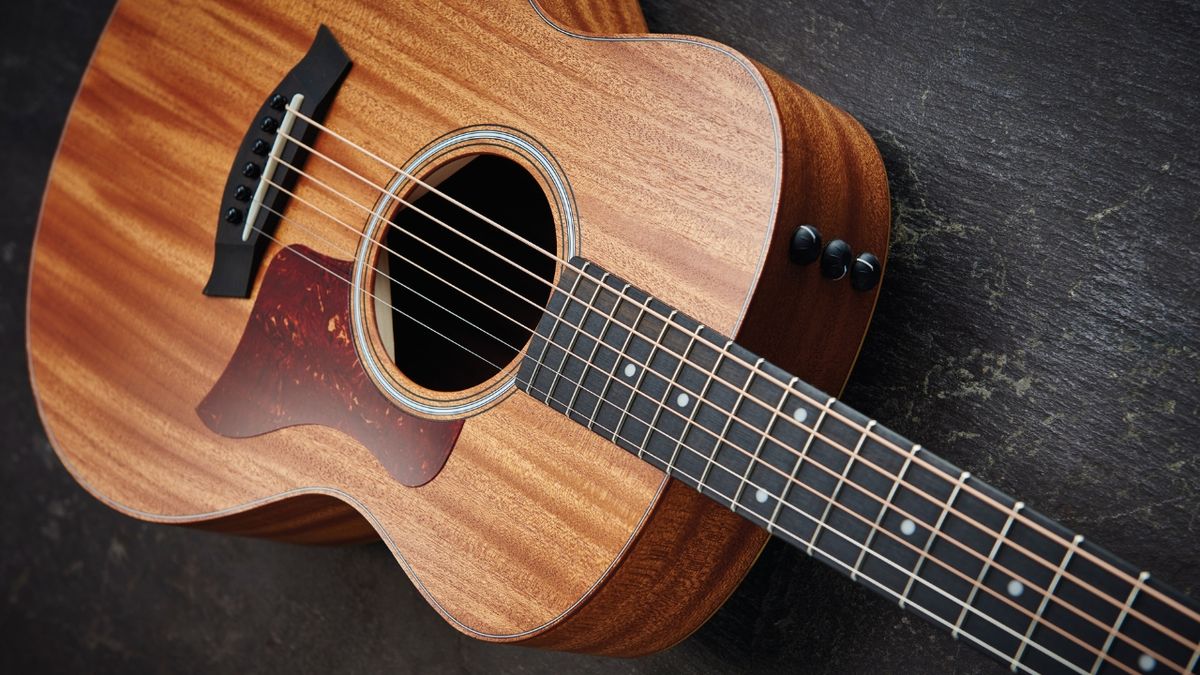
Choosing the best acoustic guitar for your personal needs is a tough one. With so many options on offer these days it’s not surprising that many find themselves faced with option paralysis when looking at tonewoods, bracing patterns, and body types. Taking all of these into account is a monumental task, but we’re here to help with our picks that are separated by price point or use case.
Our team of musicians here at MusicRadar have been reviewing guitars for decades, so all of our recommendations are backed by real-world experience. We’ve put these acoustics through their paces in various situations whether that’s the sofa in front of the TV, in the rehearsal room, recording studios, or playing them on stage. It’s all part and parcel of assessing the true quality of these instruments, putting their playability and build quality to the test in the same way you’ll use them.
We’ve put together some buying advice for those who want more information before they purchase, with loads of common questions answered by our guitar gurus. If you already know your stuff and just want to see the best acoustic available today, then keep on scrolling…
The quick list
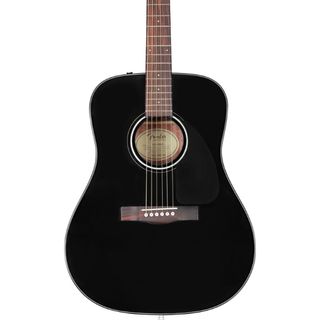
For beginner acoustic guitarists it doesn't come much better than the Fender CD-60. Blending brilliant build quality with playability, it's a springboard for any acoustic journey.
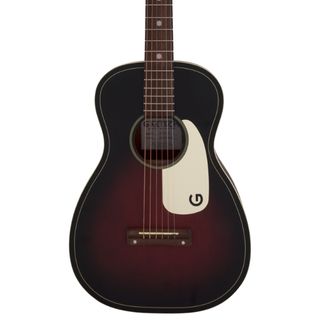
One of the best acoustic guitars for those on a budget, the Gretsch G9500 Jim Dandy is the perfect companion for songwriting or as a durable and playable sofa guitar.
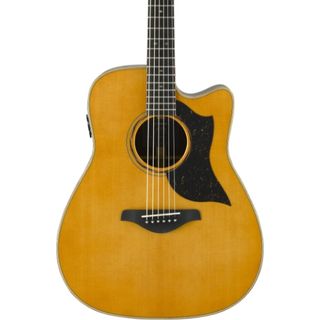
If you're after an acoustic that sounds as good plugged in as it does unplugged, you'll want to take a look at the Yamaha A5R ARE with its brilliant SRT2 preamp.
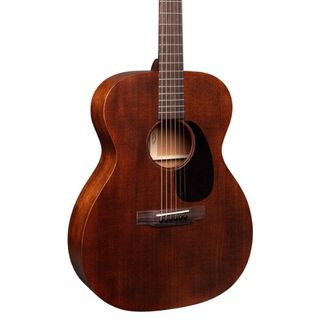
If you're looking to step up from a beginner acoustic to something of higher quality, the Martin 000-15M is a fantastic all-rounder that can cover loads of different sounds.
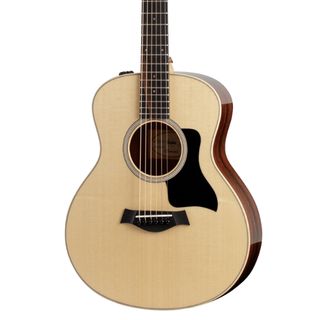
It may be small but the sound of the Taylor GS Mini is what makes it such a popular guitar. Well rounded and balanced, it's a stunning instrument below the $1,000 mark.
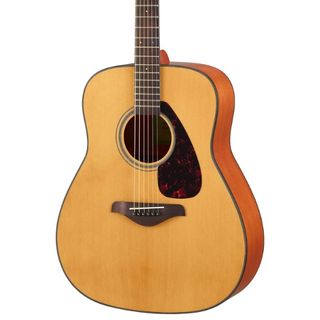
For those on tighter budgets, the Yamaha FG800 is phenomenal value for money, giving you a solid top, lovely playability, and excellent unplugged tone for well below $500.
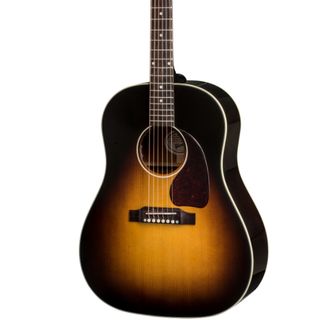
We love this guitar for its blues chops, but the Gibson J-45 is versatile enough to handle fingerstyle, chords, arpeggios, Country, and pretty much anything else.
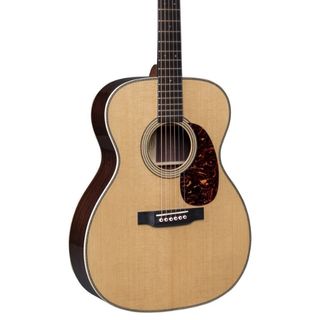
The forward-thinking Martin 000-28 Modern Deluxe features a slightly shorter scale and ultra-thin, asymmetrical neck profile making it perfect for fingerstyle acoustic guitar playing.
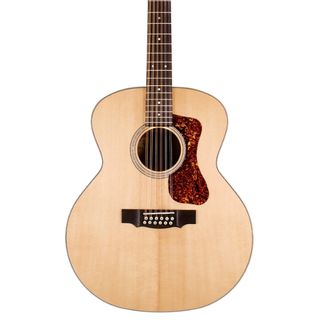
Sitting in that Goldilocks zone between usability and great value, the Guild F-1512 is our top pick for those searching for their perfect 12-string acoustic guitar.
Best for beginners
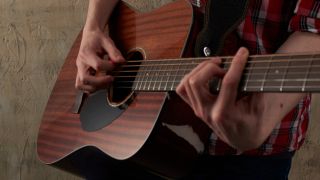
Specifications
Reasons to buy
Reasons to avoid
✅ Buy if you want a big brand, beginner acoustic: Being backed by one of the biggest brands in the world is a comforting feeling when buying your first acoustic guitar.
❌ Avoid if you're a very young beginner: This is a full-size dreadnought instrument, so will likely be too big for younger children to start learning on.
The Fender CD-60 is a good reminder of just how much guitar you can get for your money at the more affordable end of the market. We've come far since the days of high-action, poor tuning stability, and shoddy construction that used to mark out lower-priced models. Instead, we're offered a spruce top, laminated mahogany back/sides, and a playable Walnut fretboard.
The CD-60's action is great out of the box, too, though not too low to make us wary of alternate tunings. The punchy character of Spruce is certainly here, bringing the brightness usually associated with these tops.
The result is something that’s genuinely inspiring to play and chimes in chord work, and one of the best acoustic guitars for beginners or those looking for a second acoustic. After all, why should new players settle for just okay when they need to be comfortable and inspired? And there’s no reason why this dreadnought wouldn’t be a good addition for anyone else, too.

"Marrying a solid mahogany top with laminated mahogany on the back and sides, the CD-60S is a very attractive beginner's dreadnought with a bright, articulate and well-balanced voice." Read our full Fender CD-60 review
Best on a budget
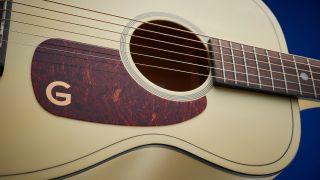
Specifications
Reasons to buy
Reasons to avoid
✅ Buy if you want a guitar to noodle on the sofa: The tiny size and low cost of the Jim Dandy make it a perfect living room guitar that anyone can pick up.
❌ Avoid if you have big hands: It's a small guitar so the fretboard might feel cramped for those who have bigger hands, and can make fretting certain chords difficult.
With more and more players looking to both save costs and space, we’ve seen a huge resurgence in travel and parlour-sized acoustic over the last few years. The Gretsch G9500 Jim Dandy ticks all these boxes, providing a brilliantly playable instrument that is one of the best cheap acoustic guitars we've gotten our hands on.
Of course, due to the size, it won’t compete with a boomy dreadnought, but the sound has an endearing character all of its own. It’s bright but never harsh with bags of articulation and a strong attack. It really punches above its weight and price tag when it comes to note clarity, excelling at flatpicking and fingerpicking.
You’d expect at this price point that the hardware might not be the best, but we were surprised at how good the tuners are. They don’t feel cheap and hold their tuning particularly well. We also love the vintage style finish and the small body size which makes it perfect for strumming and songwriting at home.

"With the right performance and useful spec at a ridiculously low price point for a heritage brand, the Gretsch G9500 does indeed pull off the tricky task of delivering more quality than its cost would normally permit." Read our full Gretsch G9500 Jim Dandy review
Best electro-acoustic
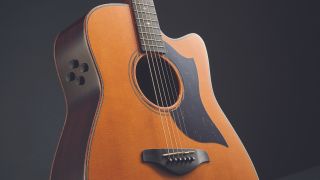
Specifications
Reasons to buy
Reasons to avoid
✅ Buy if you want a brilliant gigging guitar: The SRT2 preamp onboard the Yamaha A5R ARE are some of the best we've ever heard, making it a proper gigging machine.
❌ Avoid if you prefer traditional guitars: You can only get a cutaway version of this guitar, so if you prefer a traditional-looking acoustic guitar then steer clear.
There is traditionally a gap between how we enjoy the sound of our guitars and the way they’re represented plugged in. Enter Yamaha acoustic guitars, a leader in stage-ready acoustic technology for decades – and in the A5R ARE, it may have just offered us a very desirable solution.
The A5R's rounded fretboard edges offer an enjoyable playing experience that mimics the feeling of guitars that have been played in to a degree and it has an ethereal quality in the high ranges, even though some treble resonance is traded with the lower action.
The A5R’s resonance and bright balance are a fine showcase for the clever SRT2 preamp – we actually couldn’t dial in a ‘bad’ sound on it because the treble and bass controls mirror the natural subtlety of the pickup/mic dynamic design.
An electro experience that captures the sound of an unplugged acoustic? The SRT2 is one of the closest acoustic-electric guitars to get there yet. This is an update that marks the A Series out as an essential consideration for players who rely on a consistent and controllable stage sound.

"A great-looking cutaway dread’ with plenty to offer." Read our full Yamaha A5R ARE review
Best under $2,000
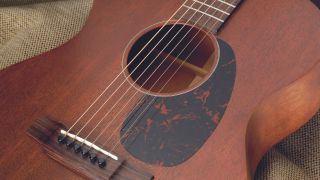
Specifications
Reasons to buy
Reasons to avoid
✅ Buy if you want a no-frills acoustic that sounds incredible: Some may judge its looks as plain, but the Martin 000-15M has a beautiful voice and outstanding playability.
❌ Avoid if you want booming lows and sparkly highs: Both the size and tonewoods used mean that this guitar isn’t quite as full range as a dreadnought or spruce-topped acoustic.
The Martin 000-15M is one of our all-time favourite acoustic guitars thanks to its unbelievable unplugged tone, solid tonewoods, and outstanding playability, all at a fantastic price point. It’s a no-frills look and purposeful design come together to make a sensational acoustic that’s well worth the money.
Despite it’s all mahogany construction, the 000-15M is super balanced across the tonal spectrum, with none of that ‘honk’ you usually find in acoustics of a similar spec. It’s super responsive and plays just as great with open tunings and slide guitar as it does with open chords accompanying a vocalist.
Due to the size and construction, it’s not quite got as much bass and treble as a dreadnought or Sitka spruce-topped instrument, but we’d wager that this makes it fit better when playing with ensembles. It’s a simply superb Martin guitar that is sure to bring a smile to your face.

"It looks brilliant, plays and sounds amazing and at this price point, its Guitarist Gold award must be the no-brainer of the century." Read the full Martin 000-15M review
Best under $1,000
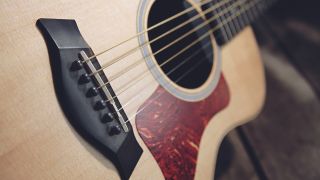
Specifications
Reasons to buy
Reasons to avoid
✅ Buy If you want a compact guitar that sounds great: The GS-Mini is incredibly popular thanks to its combination of small body size yet remarkably full acoustic voice.
❌ Avoid if you need unplugged volume: Despite its fantastic voice, it still won't compete with a dreadnought or jumbo-sized guitar if you need volume playing unplugged.
The Mexican-made Mini is equally functional as both a travel guitar and "modern-day parlour guitar". Despite its small footprint, the GS Mini is no toy instrument: there's a solid Sitka spruce top, a faultless build quality and the setup is immaculate, making it our pick of the best acoustic guitars under $1,000.
The slight, soft 'V' profile of the neck combined with narrow nut width makes this acoustic feel much more like an electric guitar, in spite of the standard 56mm string spacing. It gives the GS Mini a really comfortable playing feel, particularly when you're strumming chords, though fingerstyle players might prefer a little more room.
Rather like a good parlour-size guitar, the GS Mini outputs a sound that belies its compactness. We'd lay a considerable sum to suggest it'd be a fine recording guitar, that tight low end giving space to a bass guitar (or bassier six-string) while the mids aren't overly honky, as some parlours can be, and the silky, sparkly highs are pure Taylor fidelity. Far from a gimmick, this is a guitar with its own vibe and voice – and both are very appealing.

"More than just a travel guitar, the GS Mini has its own acoustic voice that can easily be amplified with the good-sounding ES-Go pickup. Impossible not to like." Read our full Taylor GS Mini review
Best under $500
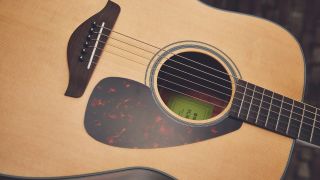
6. Yamaha FG800
Our expert review:
Specifications
Reasons to buy
Reasons to avoid
✅ Buy if you want value for money: Seeing a solid top at this price point is pretty unusual, which means you get a lot for your money with the FG800.
❌ Avoid if you're not a beginner: The FG800 is primarily aimed at beginners, which means its lacking in the bells and whistles other, more expensive models will have.
If your budget for a new acoustic guitar is quite tight, the Yamaha FG800 gives you a lot for your money. It packs a solid top, a comfortable smaller body shape, and excellent build quality, making it our pick of the best acoustic guitars under $500.
It’s very much a barebones acoustic, so you won’t find any extra flourishes or frills here. That said, everything is really nicely put together with no hint of sharp fret ends or any blemishes that we could discern on our review model.
In terms of tone, it is lively and open-sounding, projecting really well thanks to that solid top. The lows are nice and roomy, with plenty of thump in the lower mids and crisp top end. The playability is great out of the box too and at this price point you’ll be hard-pressed to find anything better.

"An impressive acoustic at a wallet-friendly price." Read our full Yamaha FG800 review
Best for blues
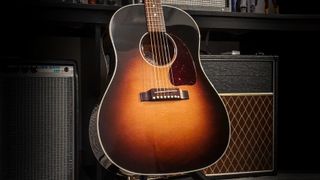
Specifications
Reasons to buy
Reasons to avoid
✅ Buy if you want a super versatile instrument: The J-45 is an incredibly versatile acoustic guitar that's at home playing slide blues, big open chords, or fingerstyle.
❌ Avoid if you don't like big guitars: This is a dreadnought-sized guitar so won't be comfortable for younger players or those of a smaller stature.
If you’re after an acoustic guitar that can handle any playstyle and genre of music you throw at it, then you need a Gibson J-45 Standard. It’s a high-end acoustic guitar, one that has the tonal versatility and build quality to ensure it performs time after time on stage and in the studio.
We found the J-45 to be an absolute tone monster, easily handling blues, fingerstyle, chords, arpeggios, and pretty much anything else we could throw at it. The clarity and note separation is particularly apparent on this guitar, and it’s super dynamic too, responding just as well to gentle fingerstyle as it does hard strumming.
With Grover Rotomatics tuners and an LR Baggs preamp system, you’ve also got some fantastic quality hardware to lean on. The amplified tone represents the unplugged sound really well, sounding fantastic through an acoustic guitar amplifier or a PA system.

"Its warm bellowing tone, effortless playability and charming good looks combine to create a truly timeless instrument. As well as the tried a tested formula of solid mahogany and sitka spruce, this modern version of the "workhorse" includes the LR Baggs VTC pickup system, which we feel is a match made in heaven." Read our full Gibson J-45 Standard review
Best for fingerstyle
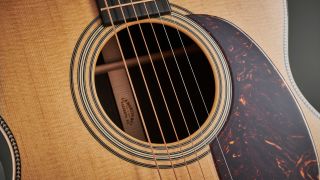
Specifications
Reasons to buy
Reasons to avoid
✅ Buy if you want a fingerstyle guitar: The ultra-comfortable neck makes this a perfect guitar for lovers of fingerstyle acoustic.
❌ Avoid if you're on a budget: This is a premium-level acoustic, so not one for those who are looking to maximize a smaller budget.
The Martin 000-28 Modern Deluxe is a premium acoustic guitar that will suit those who want to play fingerstyle. Packed with modern appointments and tech, it delivers a phenomenal unplugged tone and playability befitting of the stature implied by its lofty price point.
Featuring some of the most outstanding build quality we’ve seen, the 000-28 features a titanium truss rod, composite carbon fiber bridge plate, and Liquidmetal red dot bridge pins, the latter of which contribute to a 3-4dB volume increase. The asymmetrical neck shape gives it a unique, yet super comfortable playing feel in the hand.
The super thin nature of the neck and slightly shorter than usual scale length is what makes it feel so comfortable when playing fingerstyle, and those classical-style large chord stretches are an absolute breeze. The sound is detailed, resonating powerfully in the low end with a lovely chime and overall warm tone. A spectacular instrument that’s well worth the investment.

"The difference you find here is real with additional volume, enhanced projection, greater sustain - and that’s on top of the renowned Martin tone. You really can’t go wrong." Read our full Martin 000-28 Modern Deluxe review
Best 12-string
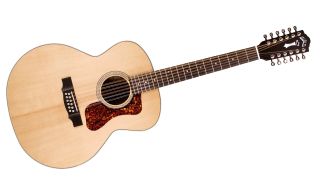
9. Guild F-1512
Our expert review:
Specifications
Reasons to buy
Reasons to avoid
✅ Buy if you want a great value 12-string: Combining high-quality construction at an affordable price point, this is the 12-string that will suit the vast majority of players.
❌ Avoid if you've got small hands: 12-string guitar necks are extra chunky to accommodate the increased number of strings. This can make them difficult to wield for players with smaller hands.
The original Guild F-512 is considered one of the all-time classic 12-string guitars, but with a suitably hefty price tag, we’ve opted for the slightly cheaper but no less brilliant Guild F-1512 as our pick if you’re after a shimmery 12-string acoustic.
The sound is loud and full thanks to the jumbo-sized body, with all that glorious chime you’d want from a 12-string. With so many things that can potentially go wrong with this style of guitar in terms of tuning and intonation, this Guild really is a thing of beauty, sounding and playing incredibly well out of the box.
The neck is on the chunky side, which is unavoidable due to accommodating all those extra strings, but it managed to be comfortable enough for our average-sized hands. The overall feel will take some getting used to if you’ve never played a 12-string before, but the incredible sound makes the effort totally worth it.
Also tested
As far as we're concerned the above acoustic guitars are where you should place your hard-earned cash, but we're also aware that they might not cover every use case for acoustic players. If you didn't find what you were looking for in our top picks, then here's a selection of acoustic guitars we've reviewed and rate highly.
PRS SE P20E Tonare Parlor | Mahogany Top | Mahogany Back & Sides | Mahogany Neck | Ebony Fretboard
Parlour acoustics are all the rage right now and when you look at the PRS SE P20E Tonare Parlor, it’s no surprise really. Packing a whole load of tone into an easily transportable package, it’s an excellent value acoustic for playing at home and songwriting.
MusicRadar Score: 4.5/5
Read our full PRS SE P20E Tonare Parlor review
Fender American Acoustasonic Telecaster | Spruce Top | Mahogany Back & Sides | Mahogany Neck | Ebony Fretboard
Fender’s 'is it or isn’t it' Acoustasonic range has been an absolute smash hit. Whether you think it’s a true acoustic guitar or not, there’s no denying the Fender American Acoustasonic Telecaster is a brilliant instrument, and certainly worthy of a place on this list.
MusicRadar Score: 4.5/5
Read our full Fender American Acoustasonic Telecaster review
Gibson Montana Hummingbird | Spruce Top | Mahogany Back & Sides | Mahogany Neck | Rosewood Fretboard
From top to bottom, this Hummingbird creates a buzz. It’s such a simple guitar to play that it’s rare to ever feel like you’re incapable of striking the right chord – especially on a neck that’s just 12” in radius. A versatile instrument that can cover a lot of ground.
MusicRadar Score: 4.5/5
Read our full Gibson Montana Hummingbird review
Taylor Builder’s Edition V-Class K14ce | Spruce Top | Koa Back & Sides | Mahogany Neck | Ebony Fretboard
The Builder’s Edition V-Class K14ce is a bold statement of intent by Taylor, combining V bracing with a notably different, more comfortable, Grand Auditorium style. Of course, its build quality is nothing short of exceptional as we’d expect – not least at this price.
MusicRadar Score: 4.5/5
Read our full Taylor Builder's Edition V-Class K14ce review
Seagull S6 | Solid Cedar top | Laminated wild cherry back & sides | Silver leaf maple neck | Rosewood fretboard
The Seagull S6 Standard has been one of the go-to beginner acoustic guitars for a long time now. A sub-brand of Godin, it’s an excellent choice for the beginner guitar player or someone who’s looking for an additional guitar but doesn’t want to spend loads of cash.
MusicRadar Score: 4/5
Read our full Seagull S6 review
Fender Highway Series Parlor | Mahogany/Sitka Top | Mahogany Back & Sides | Mahogany Neck | Rosewood Fretboard
If you want something more advanced than a traditional acoustic guitar, the Fender Highway Series Parlor will bridge the gap between classic and modern. Packed with forward-thinking features, this playable instrument straddles a fine line admirably.
MusicRadar Score: 4/5
Read our full Fender Highway Series Parlor review
Epiphone J200 EC Studio | Solid spruce | Select maple back & sides | Hard maple neck | Pau Ferro fretboard
The Epiphone J200 EC Studio pays homage to its Gibson counterpart, with stunning vintage correct stylings. The mustache bridge, decorative tortoiseshell-style pickguard, and pearloid crown inlays add a level of class to this instrument. It sounds as good as it looks, as well.
MusicRadar Score: 5/5
Read our full Epiphone J200 EC Studio review
FAQs
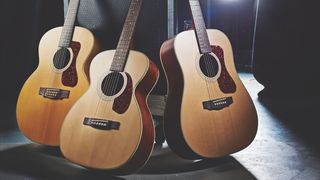
What acoustic guitar should I buy?
We’ve got good news when it comes to how much you need to spend. If you want to, you can spend tens of thousands on one of the best acoustic guitars - but that is in no way necessary. Between the guitar players on the MusicRadar team, we’ve bought, sold, and played thousands of acoustic guitars, so here’s what we’d expect to spend on some great beginner, intermediate, and pro acoustic guitars:
As a beginner, you’ll get everything you need for under $/£500. You’ll need something comfortable, nice to look at, and easy to play. You’ll get all of these qualities from manufacturers like Fender, Epiphone, and Washburn, among many others. These manufacturers are our favorites for the best cheap acoustics as they’re well-respected brands that won’t put their names on sub-par instruments.
For intermediate players, you’ll be best off spending a bit more and getting something special. You’ll be able to find guitars of all shapes, sizes, build qualities, and brands - the world starts to become your oyster. For $/£1,500, you’ll even start creeping up into the world of higher-end Far-Eastern and lower-end USA-made guitars, from the likes of Martin, Gibson, Taylor, Yamaha, and Guild. The quality of the build, materials, and tone will be noticeably better than that of a cheaper, sub-£/$500 acoustic guitar - so if you can afford it, then we’d recommend going for an intermediate spec acoustic.
Once you enter the realms of ‘professional’ acoustic guitars, you can really spend as much as you want. You can spend some serious money on high-end acoustic guitars, with Martin’s £7,000 ‘Authentic’ range and Taylor’s indulgent Builder’s Edition acoustics being prime examples. These guitars feature endangered woods, incredible build quality, and gargantuan tones, among other things. For over $/£1,500 though, a pro will get everything they need to play, sound, and look great. Expect to see those aforementioned manufacturers’ names pop up a lot in this price bracket, along with companies like Larivee, Furch, Eastman, and many more.
When was acoustic guitar invented?
The acoustic guitar has gone through many iterations and revisions to get to where it is today. The origins of the acoustic guitar are often argued, but it most likely was influenced and inspired by the gittern - which originated in Western Europe during the 13th century. The vihuela - which came to be in 15th century Spain, and was more ‘traditionally’ guitar-shaped - took two routes, the most important to us being the vihuela de Penola. This was played with a guitar pick or by hand.
Around the late 1700s and early 1800s, six-stringed versions of the vihuela became popular. In approximately 1850, a luthier named Antonio Torres Jurado made improvements to the tone and strength of these instruments - increasing the body size, altering the proportions, and using a ‘fan’ bracing pattern. Torres’ design has remained fairly unchanged, and most credit the form and structure of the modern acoustic guitar to him.
Is acoustic guitar harder than electric?
In our experience, yes acoustic guitars are harder to play. Electric guitars are far more forgiving due to their thinner necks, more agile body shapes, and strings that are generally closer together and thinner. Electric guitars can also cover up certain imperfections with the use of effects pedals like reverb, delay, and overdrive.
The reason many beginners are pushed into using acoustic guitars is precisely because they are harder to play. The thicker, less forgiving strings of an acoustic help you develop your hand strength, intonation, and picking without anything covering up bad technique.
Of course, there are no rules that say you have to learn on an acoustic, and there are plenty of brilliant beginner electric guitars out there to choose from.

What are the different acoustic guitar types?
Acoustic guitars come in many different shapes and sizes, the most popular being Dreadnought, Grand Auditorium, and Parlor, among others. Each of these styles brings its own characteristics to the table, so consider them carefully when choosing the best acoustic guitar for you.
Generally speaking, the bigger the guitar, the bigger the sound. The smaller the guitar, the tighter, and more focused the sound. Perhaps that's obvious, but you'll want to consider the effect on tone too.
Dreadnought and Jumbo guitars generally deliver a deeper sound and increased bottom end due to their cavernous body sizes. These are a favorite of legendary solo singer-songwriters such as Johnny Cash, Bob Dylan, and Sheryl Crow, as the increased volume and tone can make up for the lack of full-band accompaniment. This massive sound can get lost in a band situation though, as the extra bass and low mid frequencies interfere with a bass guitar or kick drum.
If you’re looking to perform with a band, a smaller-bodied guitar - like a Grand Auditorium, ‘000’ or Parlor may be more suitable. Acoustic guitars of these sizes will cut through a mix better as they generally produce more high-mid and treble frequencies - or at least fewer low frequencies - to ensure you're heard over the rest of the band. With players such as John Mayer, Eric Clapton, and Myles Kennedy opting for a smaller-bodied acoustic guitar, it's worth checking them out.
Bear in mind that the size not only affects the tone but also how comfortable the guitar is to play. So if you feel better playing a smaller guitar, then go for it. You have to be comfortable with your instrument.
How much does it cost to get a pickup in an acoustic guitar?
An acoustic guitar pickup can cost anywhere between $100 to $300, and installation will be charged at a guitar tech's hourly rate, with the time varying greatly depending on the style of pickup. Some pickups are relatively easy to install yourself, and there are plenty of YouTube tutorials to help you out. Others will require serious modification that's probably best left to a professional unless you really know what you're doing.
The most popular pickups are under-saddle piezo pickups. As you’ve probably worked out, the pickup collects the string vibrations through the saddle and then sends that tone to the output jack. Unfortunately, a cheap one can sound quite brittle and spiky, as the pickup detects vibrations where the string tension is at its tightest.
Another pickup type is the magnetic soundhole pickup. They work exactly the same as an electric guitar pickup, in the way that they create a magnetic field that captures the vibrations of the strings, and then passes those through to the output jack and into your amp. They’re pretty easy to install - most just clip on either side of your soundhole - and they’re available in single-coil and humbucker configurations. Some are active, too - meaning the output is higher and your tone will pop even more.
You can also use a soundboard transducer pickup if that’s more your thing. If you use percussive techniques in your playing, then these pickups can be a great choice - as they can be fixed anywhere on or inside the body of your acoustic guitar, picking up more vibrations than other types of pickups. They often need a bit more EQ tweaking on your amp or PA speakers to get them to sound perfect, but it’s worth the effort if your playing style requires one.
You may not know if you'll ever want to plug into an acoustic amp or even PA speakers, and, of course, you could always have a pickup installed at a later date. Still, we recommend opting for a steel string with an onboard pickup/preamp if it's within budget. As they say, it's better to have it and not need it than to need it and not have it!

Are acoustic guitar strings the same as electric?
Acoustic guitar strings are not the same as electric guitar strings. Both feature different coatings, with electric guitar strings requiring steel or nickel coating with ferromagnetic properties to enable the guitar pickups to work. Acoustic strings generally feature brass or bronze coatings which are generally much brighter sounding than their electric equivalents.
Can I put nylon strings on an acoustic guitar?
Technically you can do this, but we wouldn't recommend it. The reason is due to string tension. Steel strings impart a huge amount of tension on the neck of your acoustic guitar, whereas nylon strings will only use about half of the same amount. This can mean issues for the neck of your instrument if you don't perform a truss rod adjustment.
You may also encounter issues with the nut, as nylon strings are much thicker than steel strings, as well as problems anchoring the strings to the bridge of the guitar. It can be done, but if you want a nylon string acoustic, just go ahead and buy a classical guitar.
Should I buy an acoustic guitar online?
Concerned about buying an acoustic guitar online without trying it first? You needn’t worry. Online music instrument retailers like Sweetwater, Thomann, Guitar Center and Musician’s Friend offer hassle-free returns as standard, so you can purchase a guitar, play it in the comfort and privacy of your home and, if it’s not right, send it back with ease. Check the specific returns policy for your chosen retailer before you purchase, but most offer between 30-45 days to return an item, as long as it’s in original condition.
How we test
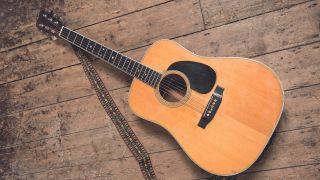
Acoustic guitars are some of the most subjective instruments out there. Every player has their own set of preferences - but there are a few key criteria every acoustic guitar should meet before we recommend it to our readers.
1. Build quality - The first thing we look at is the overall build quality of the instrument. Does it feel strong, solid and can it withstand hard playing? We need to make sure any acoustic guitar we recommend is sturdy and reliable, and won't let you down. How well does it all fit together? How good is the hardware? Is the level of finish up to scratch? These are all questions we seek the answers to during testing.
2. Quality control - We then check the setup, and the level of finish of the guitar. We look at the action (the vertical distance between the strings and the fingerboard), and also the fretwork - to make sure there are no dead spots or sharp fret ends. This is all done through the lens of the instrument's cost of course - we wouldn't expect the same level of quality for an instrument that costs $200 versus one that costs $2,000.
3. Playability - We check how comfortable the neck and body are, how the neck profile feels in our hand and how the fingerboard radius feels when playing. We'll put the instrument through various playing techniques including open chords, fingerstyle, hybrid picking and anything else we feel a particular guitar warrants. We'll also play sat down and stood up to see if there's any neck dive.
4. Sound - We've also got to test the sound of the guitar. For this, we play a variety of different styles including country-style chicken-pickin', strumming with a plectrum and everything in between. We play throughout the whole dynamic range of the guitar, and listen to the tone and projection to make a judgement on its overall sound.
Read more about how we test music making gear and services at MusicRadar.
Why you can trust us

✔️More than 9,500 reviews on-site
✔️Over 17 years of product testing
✔️ 2.9 million monthly users globally
With more than 17 years of experience, MusicRadar is the premier music-making website in the world. Run by musicians for musicians, we offer expertly written gear round-ups and high-quality, authoritative reviews by an extensive team of highly experienced industry professionals.
We also interview world-renowned musicians and stars about their creative processes and the nuts and bolts of their gear and technique. This gives fans an insight into the actual craft of music-making that no other music website can.
But that's not all. We also provide excellent tuition, from bite-sized tips to advanced techniques and guidance from recognised musicians.
As well as delivering high quality written reviews and features, we also produce a wealth of video content on YouTube. MusicRadarTV is where you'll find all of our access-all-areas interviews, hot gear demos and exclusive video lessons.
Related buyer's guides
MusicRadar's got your back
- Record the perfect take with the best acoustic guitar mics
- Improve today with the best online guitar lessons sites and apps
- Cover your gear with our guide to musician's insurance
Get the MusicRadar Newsletter
Want all the hottest music and gear news, reviews, deals, features and more, direct to your inbox? Sign up here.
Chris has been the Editor of Total Guitar magazine since 2020. Prior to that, he was at the helm of Total Guitar's world-class tab and tuition section for 12 years. He's a former guitar teacher with 35 years playing experience and he holds a degree in Philosophy & Popular Music. Chris has interviewed Brian May three times, Jimmy Page once, and Mark Knopfler zero times – something he desperately hopes to rectify as soon as possible.
- Daryl RobertsonSenior Deals Writer
- Matt McCrackenJunior Deals Writer
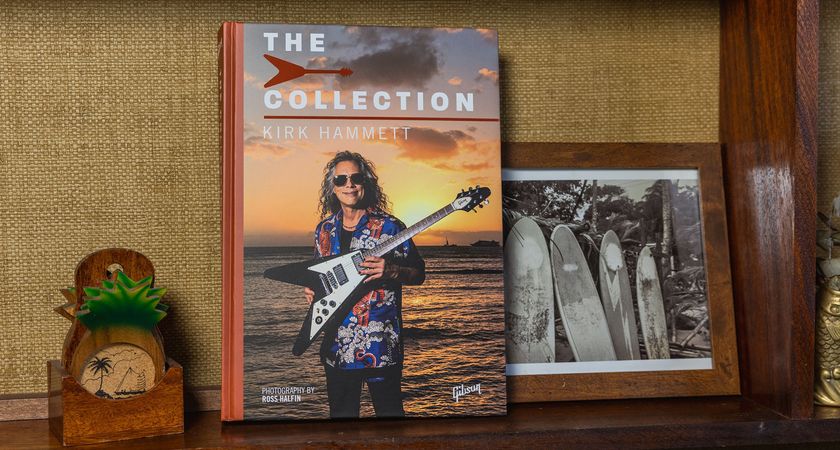
“The deepest-ever dive into the Metallica star’s eclectic guitar collection”: Kirk Hammett and Gibson Publishing team up for epic coffee-table book
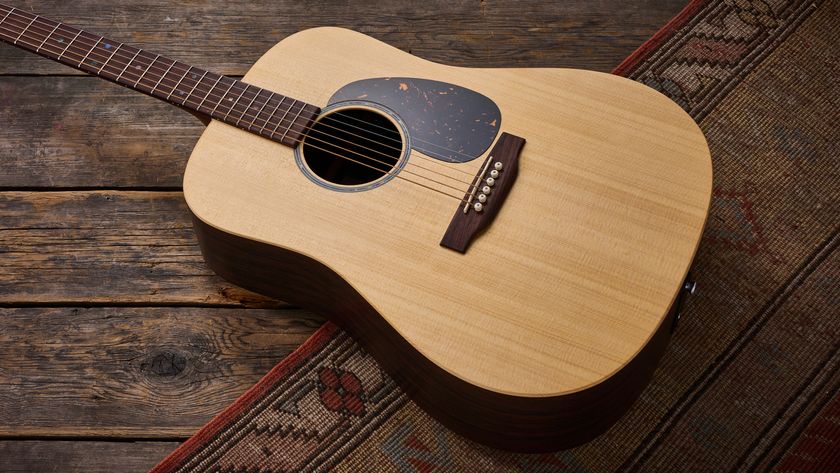
“While it might not be the vintage D-28 of your dreams, this is a Martin you can be proud of”: Martin X Series Remastered D-X2E Brazilian review
